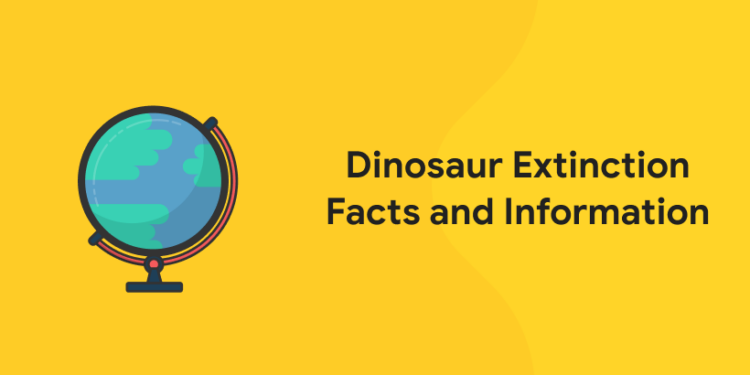Table of Contents
This article contains dinosaur extinction facts for aspirants and is a great resource for anyone of any age who wants to understand why the dinosaurs went extinct. We’re going to discuss the latest and most accurate facts about the dinosaur extinction. The dinosaur extinction facts provided in this article will help you learn what may have caused dinosaurs to go extinct, different theories about reason why the dinosaurs went extinct, and other important dinosaur extinction facts.
Basic Facts About Dinosaurs
- Dinosaurs are reptiles that have lived on the surface of the Earth for about 245 million years.
- The English naturalist Sir Richard Owen formed the term Dinosauria, In 1842. It was obtained from the Greek words deinos and sauros, which means “fearfully great,” and “lizard”
- Dinosaur fossils have been discovered on all the seven continents.
- The non-avian dinosaurs disappeared about 66 million years ago.
- There are about 700 known species of dinosaurs which are
- Modern birds are a form of dinosaur because they share the same ancestor with non-avian dinosaurs.
Attempt free GK Mock Test! Download Entri App!
Earth science
Paleontologists are like investigators who examine the evidence that the animals which got extinct left behind. Those clues to what dinosaurs were like are found in the fossils—the ancient remains of the living thing, such as teeth, bone, or shell—or indication of animal activity, such as footprints and track ways.
All the information we have about non-avian dinosaurs is based on fossils, which include bones, teeth, footprints, tracks, eggs, and skin impressions. For hundreds of years, people throughout the world have discovered amazing fossilized bones and footprints. Early finds led to legends and fairy tales, as people imagined that these bones belonged to huge monsters or giants.
Some thought that Barnum Brown, who began his career at the American Museum of Natural History in 1897, was one of the greatest dinosaur hunters of the late 19th and early 20th centuries. Barnum Brown began his career at the American Museum of Natural History in 1897. Many of his greatest discoveries, including the first specimens of Tyrannosaurus rex ever found, are on display in the dinosaur hall of the Museum.
Today, along with patience and sharp observation skills, paleontologists use new technologies to solve unanswered questions about dinosaurs and other fossils. Advanced imaging technology, such as CT scans, allow them to see the 3 dimensional structure of fossils, often without having to remove the matrix.
Paleontologists integrate the research of biomechanics, applying the principles of both physics and engineering to speculate the biological movement of non-avian dinosaurs. The information obtained from fossil bones along with observations of both the movement and the musculature of living animal species help scientists to understand how non-avian dinosaurs may have moved.
Attempt free GK Mock Test! Download Entri App!
The Age of Dinosaurs
The earliest known dinosaurs materialized during the Triassic Period (approximately 250 to 200 million ago). Dinosaurs developed into a very vast group of animals with a diverse array of physical features, including modern birds.
Contrary to what many we think, not all dinosaurs lived during the same geological era. For example, Stegosaurus, lived during the Late Jurassic Period, about 150 million years ago. Tyrannosaurus rex existed during the Late Cretaceous Period, about 72 million years ago. Stegosaurus was extinct for 66 million years before Tyrannosaurus appeared on Earth.
In the Mesozoic Era (an era of more than 180 million years which includes Triassic, Jurassic, and Cretaceous periods), a non-avian dinosaur developed into a species of avian dinosaur. This avian dinosaur is the considered as the first bird and the ancestor of all birds. All the non-avian dinosaur went extinct 66 million years ago.
There are many theories as to what might have contributed to the mass extinction of non-avian dinosaurs and other species at the end of the Cretaceous Period. It is for sure that a massive asteroid or comet struck Earth during this period, causing a dramatic shift in Earth’s climate. Some scientists anticipate that this impact had catastrophic consequences for life on Earth. But other factors, including changing sea levels and large-scale volcanic activity, may also have played an important role in this mass extinction.
Attempt free GK Mock Test! Download Entri App!
Dinosaur Fossils and Fossilization
- Paleontologists make use of fossil evidence preserved in ancient rock to find how long-extinct animals lived and behaved.
- In many cases, a fossilized bone is actually a rock consisting of minerals, with no trace of the original bone material.
- The discovery of dinosaur eggs and nests gave evidence for the activity of some dinosaurs.
- By examining the skulls of Protoceratops of different ages, paleontologists could draw conclusions about how some dinosaurs grew.
- To learn how organisms lived in the past, paleontologists look for evidences preserved in ancient rocks—the fossilized bones, teeth, eggs, footprints, leaves, teeth marks, and even dung of these
- Fossilized jaws, teeth, and dung provide significant clues about what non-avian dinosaurs ate.
- Series of fossilized footprints, called trackways, reveal some interesting evidence about dinosaur behaviour and movement.
- Until lately it was believed that feathers were specific to birds. Recent findings, however, have unearthed proof of feathered non-avian dinosaurs.
Paleontologists searching for dinosaur fossils begin their work by surveying regions to find sedimentary rock from the Mesozoic era. Finding the right spot requires experience and a keen eye.
Fieldwork is only a tiny part of what paleontologists do. They also work in the lab, investigating the specimens they’ve recovered as well as fossils collected years before. They spend a lot of time classifying specimens, determining their biological relationships and examining their characteristics.
Grab study materials to strengthen your GK !!! Register Now !!!
Teeth, Footprints, and Feathers of Dinosaurs
Many theropod dinosaurs, such as Tyrannosaurus, had teeth that were slightly curved backwards, pointed, and serrated. The sharp points cut the meat, and the serrations helped slice it by catching and tearing muscle fibers. Meat eaters didn’t cut or grind their food; they swallowed whole chunks.
Herbivorous dinosaurs had teeth of various shapes designed for their particular diets. For example, Triceratops, had 100s of teeth that formed a solid “wall” with sharp ridges. The teeth helped them to chop off vegetation. Other plant eaters, such as Anatotitan, possessed wide flat teeth that helped them to grind up tough vegetation. The long-necked dinosaurs, like Diplodocus, had long pencil-like teeth that helped to rake the leaves off branches. These dinosaurs swallowed whole leaves. They also consumed small stones, called gastroliths, to grind up the food in their stomachs, much the same way that modern birds, such as parakeets and chickens, do now a days.
From an individual footprint, scientists can guess the height of the dinosaur that made it. A rough estimate guess of leg length is acquired by multiplying the print length by four.
A footprint can also give us hints about the kind of dinosaur that made it. A 3 toed, sharp-clawed print means that it is likely to be the footprint of a theropod—usually a carnivore. A three-toed print with rounded toes mostly probably belonged to an ornithopod dinosaur—a plant eater. And pairs of unequal-sized prints were most likely the work of the four-legged,long-tailed, long-necked dinosaurs named sauropods, another group of herbivores.
Modern birds, and avian dinosaurs, have skeletal features that are identical to some non-avian dinosaurs.
Feathers developed before flight and may have functioned as insulation to keep dinosaurs warm, or for show to attract mates.
Why did the dinosaurs go extinct?
Putting together what happened has been a big effort for paleontologists, and theories for what killed the dinosaurs and the rest of the planet’s Cretaceous dwellers have ranged from the believable to the downright zany. At present, two main ideas are battling it out within the scientific community: Were dinosaurs victims of heavenly body violence, or more Earthly woes?
Attempt free GK Mock Test! Download Entri App!
Death from Heavenly Body Violence
One of the most agreed theories for the extinction of the dinosaurs is the Alvarez hypothesis, named after the father-and-son pair Luis and Walter Alvarez. In 1980, they proposed the notion that a meteor the size of a mountain crashed into Earth 66 million years ago, filling the earth with gas, dust, and debris that forcefully altered the climate.
The main piece of evidence provided by the duo is an oddly high amount of the metal iridium in what’s known as the Cretaceous-Paleogene ( K-Pg), layer—the geologic zone that seems to cover any known rock layers incorporating dinosaur fossils. Iridium is comparatively rare in Earth’s crust but is abundant in stony meteorites, which led the father and son to conclude that the mass extinction was caused by an extraterrestrial object. The theory gained even more acceptance when scientists were able to connect the extinction event to a large impact crater along the shore of Mexico’s Yucatán Peninsula. At about 93 miles wide, the Chicxulub crater appears to be the correct size and age to account for the dino die-off.
In 2016, scientists drilled a rock core inside the underwater part of Chicxulub, discovering a sample stretching deep beneath the seabed. This rare peek inside the guts of the crater proved that the impact would have been strong enough to send deadly amounts of vaporized rock and gases into the environment, and that the effects would have remained for years. And in 2019, paleontologists digging in North Dakota discovered a treasure trove of fossils extremely similar to the K-Pg boundary, essentially capturing the remains of an entire ecosystem that were present shortly before the mass extinction. Tellingly, the fossil-bearing layers contain loads of small glass bits called tektites—likely blobs of melted rock emerged by the impact that solidified in the environment and then rained down on the Earth.
Volcanic fury
However, other scientists hold back that the evidence for a massive meteor impact event is indeterminate, and that the more likely offender may be Earth itself.
Ancient lava in India known as the Deccan Traps also match nicely in time with the end of the Cretaceous, with huge outpourings of lava spewing forth between 60 and 65 million years ago. At present, the resulting volcanic rock covers nearly 2 lakh sq.miles in layers that are in places more than 6 thousand feet thick. Such a huge explosive event would have choked the skies with carbon dioxide and other gases that would have hugely impacted the Earth’s climate.
Proponents of this theory show several clues that suggest volcanism is a better fit. For some studies display that Earth’s temperature was changing even prior to the proposed impact event. Other discoveries has found proof for mass die-offs much earlier to 66 million years ago, with some signs indicating that dinosaurs in particular were already in a slow decline in the late Cretaceous. What’s more, volcanic activity is regular on this planet and is a arguable culprit for other ancient extinctions, while giant meteor strikes are not that common. This all makes sense, supporters say, if ongoing volcanic eruptions were the main cause of the world-wide K-Pg extinctions.
Attempt free GK Mock Test! Download Entri App!
Why not both?
Increasingly, scientists trying to unscramble this prehistoric mystery are seeing room for a combination of these two ideas. It’s possible that the dinosaurs were the unlucky recipients of a geologic one or two punch, with volcanism weakening ecosystems strong enough to make them undefendable to an incoming meteor.
But that impression depends a lot on more fine dating of the Deccan Traps and the Chicxulub crater. In 2019, two separate studies looked at geochemical clues from Deccan Traps lava and came to slightly different conclusions, with one paper conveying that the volcanoes played an important role in the dinosaurs’ demise by causing pre-impact declines, and the other saying the eruptions came after the impact event and may have played only a tiny role in ushering along their end.
This debate may go on for years, as scientists dig up new clues and develop new techniques for understanding the past. But whether space invaders or loads of lava are to blame, it’s distinct that scientists studying the dinosaurs’ last gasp are revealing important lessons about the effects of dramatic climate change on Earth’s dwellers.
Grab study materials to strengthen your GK !!! Register Now !!!
Dinosaur Extinction Facts
- The extinction of the dinosaurs occurred from 65 to 66 million years ago.
- The extinction event that killed the dinosaurs also let to sudden mass extinction of 75% of all living organisms on the earth.
- The extinction of the dinosaurs is formally known as the Cretaceous–Paleogene (K-Pg) extinction event, or also the Cretaceous-Tertiary (K-T) extinction.
- Cretaceous period and the Mesozoic Era end with the Cretaceous–Paleogene (K–Pg) extinction event.
- The Cretaceous–Paleogene (K–Pg) extinction event is believed to have occurred by a massive asteroid or comet impact.
- The strongest supported hypotheses for the Cretaceous–Paleogene (K–Pg) extinction event is the impact theory.
- The primary theory of an asteroid or comet causing the extinction of the dinosaurs was put forward by Luis Alvarez and his son Walter Alvarez in 1980.
- The proofs used to support the asteroid impact theory is in the Earth’s geological record. The K-Pg boundary, or the K-T boundary, is a thin layer of deposit found in the geological record. This thin layer consists of high levels of the metal iridium, which is uncommon in the Earth’s crust, but is easily found in asteroids.
- The Chicxulub crater located underneath Chixulub, Mexico on the coast of the Yucatán Peninsula, is considered to be the impact crater left by the asteroid or comet that led to the extinction of the dinosaurs.
- The asteroid or comet was approximated to be between six and nine miles wide.
- The Deccan Trap hypothesis is another extinction theory. Some scientists believe that the Deccan Traps flood basalts caused the extinction of the dinosaurs by releasing large amounts of dust, sulfuric aerosols and CO2 into the air. This would have obstructed the sun and hindered photosynthesis, ultimately collapsing the food chain.
- The multiple impact hypothesis is one more such extinction theory. Some scientists believe the Earth suffered from multiple impact events at the same time. These multiple impacts would have been same as the impact event that happened to Jupiter in the 1990s with the comet called Shoemaker-Levy 9.
- Some other dinosaur extinction theories include disease or sea level change, massive volcanic eruptions, climate change
- Finally, the extinction of the dinosaurs cleared the way for the evolution of mammals and humans. If the dinosaurs hadn’t gone extinct about 66 million years ago man may never have evolved.
Grab study materials to strengthen your GK !!! Register Now !!!
I hope this article was helpful. The key point to clear an exam lies in methodical and planned preparation. If you are a candidate who wants to pursue your dream career and looking for a good start, our Entri app has got it covered for you. Our team will help you with content and insights related to the topics of your concern. Subscribe to our app today and enrol yourself into various programmes our app offers. Tune in to the app to stay updated regarding various aspects of the subject you are interested in. Feel free to post any queries and doubts in the comment section. We will try our best to reach out. Push away all those self-doubts and negative thoughts. Try to have a clear vision. Ask yourself why you want this. Focus on the good and work hard. There is a saying that goes like this, Get up and set your shoulders to the wheel-how long is life for you? as you have come to this world leave some mark behind or where is the difference between your trees and stones they too come into existence decay and die. Each day is a precious gift bestowed upon us so make it count. Work on yourself. Stop procrastinating. Today is the day, hope for the best. Good luck.














